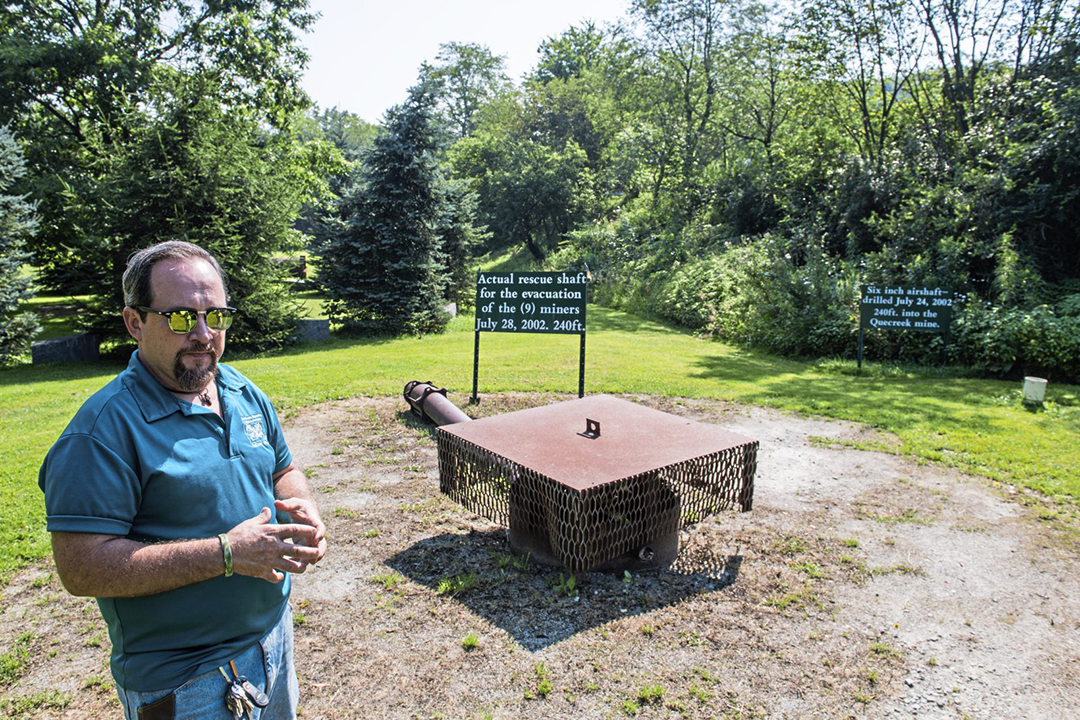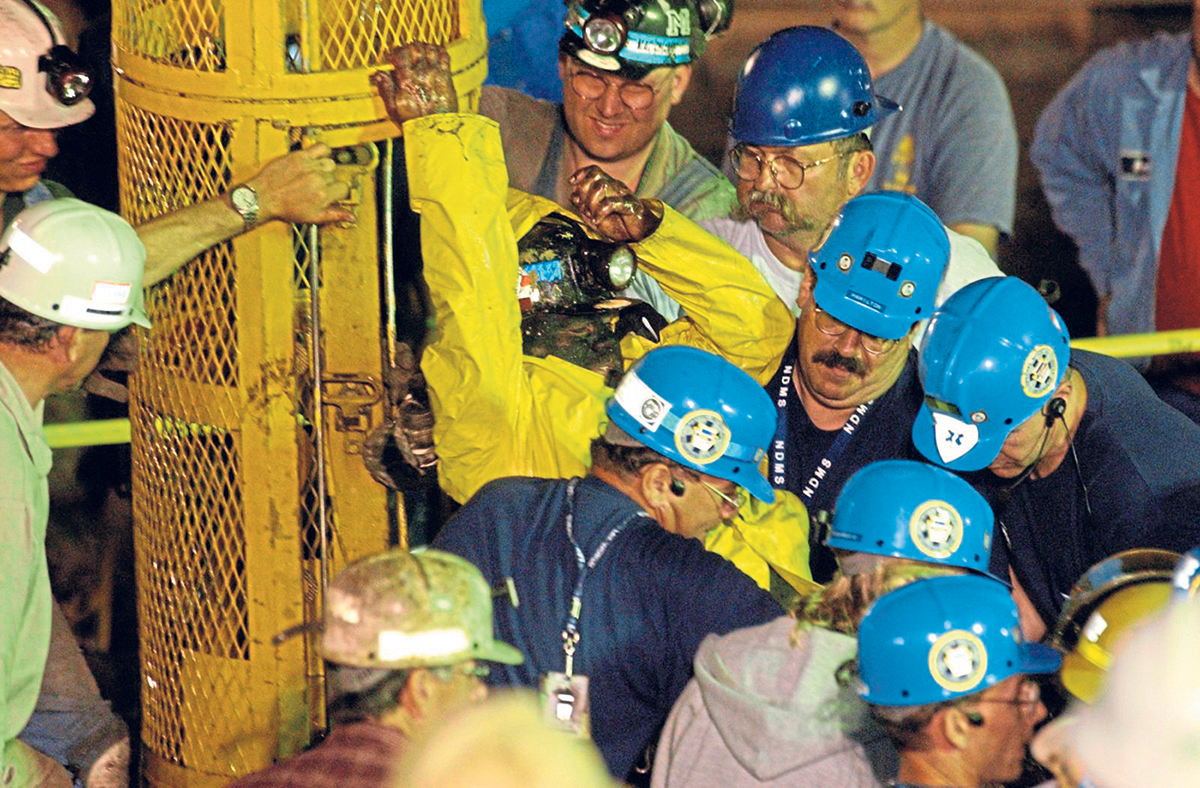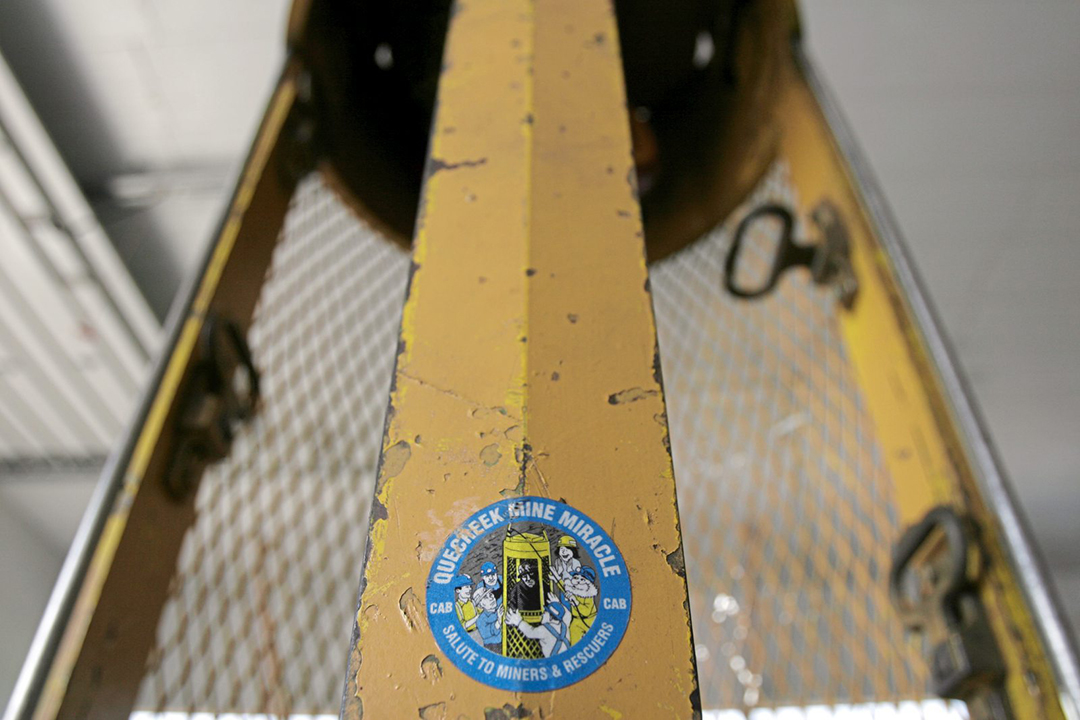

Story by RENATTA SIGNORINI
Tribune-Review
July 22, 2022
Brad Hillegass had operated a crane plenty of times but never with the lives of nine men in the balance.
That changed July 24, 2002, when nine miners were trapped 240 feet underground at the Quecreek Mine in Somerset County and his job was to safely lift them to freedom one-by-one in a slim, yellow, metal capsule through a precariously narrow shaft dug by rescuers.
Hillegass’ challenges were many, not least of which was that the rescue capsule, which had never been used before, might get hung up on the shaft. There also were concerns that hoisting the miners too quickly might result in decompression sickness.
With all that on the line, Hillegass practiced — over and over again — with the rescue capsule until the call came that the hole to the miners was completed and rescuers had spoken with the trapped men.
It was time.
“It was pretty exciting. It was a pretty unique situation,” said Hillegass, of Bedford County, who was working with a contracting crew building a bridge on the Pennsylvania Turnpike when the mine accident occurred.
With so much at stake, everything had to be perfect.
It was.
With Hillegass’ skilled hands at the controls, each miner rose to the surface to the jubilation of scores of weary, sleep-deprived rescuers.

Hillegass was one of dozens of people from around the region — and nation — who pooled their expertise, skills and equipment to accomplish what many thought was impossible.
They used drills and water pumps, fabrication shops and air compressors, to dig deep into the the earth, knowing that one bad move could be deadly.
“I no sooner asked for something, and it was there,” said Larry Neff, who worked at the time as head field engineer for Bethlehem Energy Mines. “They were just a darn good group of people.”
Pennsylvania Department of Environmental Protection and U.S. Mine Safety and Health Administration officials mobilized crews to plan the rescue. Surveyors used GPS units and mine maps to locate the best place to drill a 6-inch air hole on the Lincoln Township farm.
Rescuers knew they had the right spot when they heard tapping on the drill by the miners in the early morning of July 25, 2002.
At that stage, piping air to the gasping miners was crucial.
“That was the best thing — getting fresh air — because the air was getting pretty bad at that point because carbon monoxide was coming out of the old mine (that the miners had accidentally drilled into earlier),” said John Unger, one of the trapped miners.
Without that fresh air, Unger and the others would have suffocated.
“That first night was when pretty much all the critical decisions were made,” said Joe Sbaffoni, then the bituminous coal chief with the DEP’s Bureau of Mine Safety.
“It’s one thing to have the authority to make decisions. It’s another thing to make them,” he said. “You take it very seriously when you’re making decisions that can affect somebody’s health.”
Over the next 77 hours, rescuers were led by purpose, teamwork, ingenuity and luck.
“It was a roller coaster … everybody knew what was at stake. It was life or death,” said David Hess, then DEP secretary. “Everyone was determined. Everyone was focused, but at different parts, there was bad news.”
Some of that bad news came July 26 when a bit being used to drill the rescue shaft broke. It was later retrieved.
There are plenty of others whose roles were hidden from public view, such as the federal Mine Safety and Health Administration engineers then based in New Stanton.
Stan Michalek said he was part of that group in the office examining mine maps to determine water levels, while Kelvin Wu was on site advising rescuers.
“The Quecreek accident is a constant reminder that our work is important to protecting the lives of miners,” said Michalek, who is now a dam safety officer and chief of the mine waste and geotechnical engineering division at MSHA. Wu is retired.
Life has gone on for the rescuers despite the once-in-a-lifetime experience. People have been promoted, changed jobs and retired. Children have grown. Grandchildren have arrived. Rescuers have been tapped to give presentations about the events at conferences nationwide.
Some still have vivid recollections of how it played out.
Neff said he stayed at the site until the last man emerged from the mine, then headed to his home 20 miles away in Cambria County.
“The next day, it was (time to) get up to move cows” on the farm, he said.
For many of the drilling outfits there, it was a similar story. They completed the task, then it was time to move onto the next job site.
“It was a giant team effort,” Sbaffoni said. “The good Lord was on our side and on the side of those nine miners and their families.”
Members of the Special Medical Rescue Team shared worries about the miners’ physical conditions — they could be hypothermic, dehydrated or too injured to get into the rescue capsule. Measures to combat potential decompression sickness were factored into the rescue.
Team members, firefighters and medics practiced getting the miners from the capsule, onto gurneys and to a decontamination shower and triage tent, said Danny Sacco, who was chief of the team he co-founded with Dr. Richard Kunkle.
“We had actually choreographed this,” he said. “We didn’t want to cause any cardiac arrhythmias. We wanted to do it very smoothly.”
Sacco, then a paramedic with a background in public safety, was the first to talk to each miner as they rose to the surface.
“I was actually very surprised: They were in much, much better shape than I had anticipated,” he said. “These guys were strong men. They were coal miners. They were, I think, mentally and physically equipped to survive.”
After the men were freed, firefighters cleared out the temporary road constructed at the site, and the equipment and people departed.
Bill Arnold, who owns the farm where the mine was located, started plans for a permanent memorial, which now features a large statue of a miner and nine evergreens honoring each of those rescued — Blaine Mayhugh, Ronald Hileman, Mark Popernack, John Phillippi, Randy Fogle, Tom Foy, John Unger, Robert Pugh and Dennis Hall, who died May 13.
Pugh and Unger praised the tenacity of the team.
“You can’t say enough about the people that rescued us,” Unger said.
For some, the memories of Quecreek are never far away.
Hess said he gets the urge to visit the site when traveling the turnpike from Harrisburg to Ohio to visit his daughter. He has attended some of the anniversary celebrations.
“It’s something you think about every day because no one goes through that kind of life-and-death situation, with those kinds of stakes, with it not sticking with you every day,” he said.
Renatta Signorini is a Tribune-Review staff writer. You can contact Renatta at 724-837-5374, rsignorini@triblive.com or via Twitter @byrenatta.

Related stories
• ‘A complete miracle’: The 20th anniversary of the Quecreek Mine rescue
Coming this weekend
• ‘77 Hours of Sheer Hell’: Former Pennsylvania Gov. Mark Schweiker says Quecreek rescue proof miracles do happen
• ‘Burst of joy’: Good feelings still reverberate 20 years after first word that Quecreek miners were alive
• A lasting change: Mine safety emerged as top priority after Queecreek accident